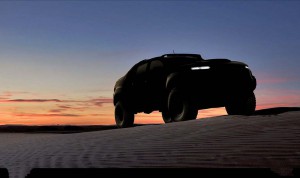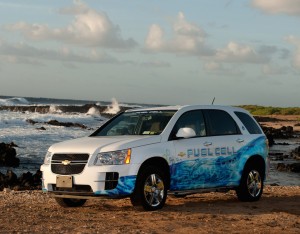The U.S. Army is enlisting some help from General Motors. They’re partnering on a prototype fuel-cell-powered Chevrolet Colorado that could eventually find applications at military bases and perhaps even on the front lines.
The prototype, set to make its formal debut in October, is a joint project of GM and the Army’s Tank Automotive Research, Development and Engineering Center, or TARDEC. It’s the latest in a series of partnerships between the Detroit automaker and the U.S. military, GM earlier this year announcing plans to develop a hydrogen-powered deep sear research mini-sub that will be tested by the Navy.
”Hydrogen fuel cells as a power source have the potential to bring to the force incredibly valuable capabilities,” TARDEC Director Paul Rogers said in a statement accompanying a teaser image of the hydrogen-powered Colorado.
Fuel-cells combine hydrogen with oxygen from the air to produce a flow of current that can be used to run the same electric motors found in a battery car – one reason they are also referred to as “refillable batteries.” Environmentalists like the technology because the only exhaust gas is water vapor, but there are other advantages.
“We expect the vehicle to be quiet in operation and ready to provide electricity generation for needs away from the vehicle,” said TARDEC Director Rogers, who noted, “Fuel cell propulsion (also) has low-end torque capability that is useful in an off-road environment.”
Fuel cell stacks also run much cooler than a conventional, internal combustion engine, something that means they have a smaller infrared heat signature when used at night in combat situations.
“With fuel cell technology advancing, it’s an ideal time to investigate its viability in extreme military-use conditions,” added Rogers.
(Ford lands $6 mil federal grant to improve fuel-cell technology. Click Here for more.)
There are some challenges to using the technology, however. Fuel cell stacks are still expensive, though that is less of an issue for the military than for the average consumer.
The bigger challenge is finding sources of hydrogen in the field. Today, there are only a dozen or so retail hydrogen pumps available in the U.S. That lack of infrastructure has limited the availability of retail fuel-cell vehicles to a narrow region in Southern California.
(Nissan exploring new approach that could eliminate hydrogen infrastructure problem. Click Here to see how.)
Currently, three manufacturers – Toyota, Honda and Hyundai – are taking orders for hydrogen cars in the U.S., but other manufacturers, including GM, are expected to enter the market as more filling stations come online.
The military actually could have an advantage of civilian applications. One way to produce hydrogen is to electrolyze water, and the relatively simple technology could readily be set up at any Army base that has a steady supply of electricity.
“This project is another example of how fuel cell propulsion can play a role in non-traditional applications,” said Charlie Freese, executive director of GM’s Global Fuel Cell Activities. “We need to continue pursing these opportunities along with our plans for production of a commercial fuel cell system in the 2020 time frame.”
The Chevrolet Colorado fuel-cell prototype will make its debut in October at the fall meeting of the Association of the United States Army, in Washington, D.C.
GM already has another fuel-cell project collaboration with the U.S. military in the works. In June, the automaker announced it is teaming up with the Navy to develop a new generation of unmanned undersea vessels that could operate independently for as long as 70 days at the time.
“If you want long endurance you really need fuel cells,” said Karen Swider-Lyons, head of the Alternative Energy Section at the Naval Research Laboratory.
She said the hydrogen-based powertrain technology is already in place. The Navy is still working on the autonomous guidance system, however.
(For more on the hydrogen mini-sub project, Click Here.)



